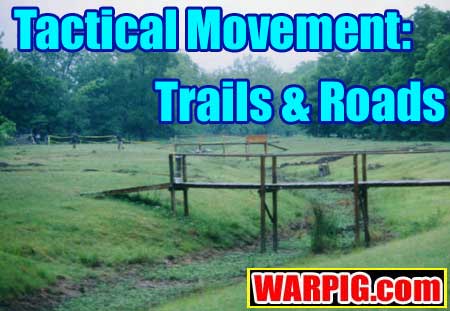  |
|
|
|
|
|
|
  |
|
|
|
|
|
|

What do you think? Add your comments in WARPIG's REC TALK Forum
|

Tactical Movement Crossing Danger Areas by Jon T. Harris Jon Harris takes military movement tactics and translates them for application in the paintball scenario and big game. In this installment, Jon lays out a plan for crossing a dangerous open space such as a creek, road, or power line easement. The object of this drill is to have the team cross the danger area in the formation and location specified by the team leader. On the far side of the danger area, team personnel and equipment are accounted for. The team continues the mission. This is done in a series of steps. Below is directly out of the US Army FM 7-8 What I want to do here is first leave the Army doctrine in place and then after you finish reading this Ill explain how it really works. Army speak starts
here:
Well my team of real soldiers didn't. This simple little drill was practiced maybe 50 times before it really worked the way it should and we were supposed to know what we were doing. So, in the paintball field it works the same way. Throughout this site I'm sure you have noticed that I preach practice and practice as a team. Do the little things and get them down, cold. Then start putting those small tasks and drills together and build into a real formidable team. So, enough jaw jacking, let's break
this down.
The crossing So your team is moving through the woods
and comes upon a path. You have to get your team across this path.
It is about 20 feet wide, which is about the same as a two-lane road. There
are woods on either side. From your side of the road you can't really
see into the other side woods more than a few feet. So, what do you want
to do? Normally in paintball the team will either run across, or
maybe even try to cross all at once in a mad dash. I want you would-be
team leaders to ask yourself a question.
Actually it's all three, but you knew that. Also we need to back up a bit here and talk about how you get to this danger area. How is your team organized? There are three basic formations (organizations) for moving your team through the bush. An Army acronym called METT-T will determine how this happens. For your learning pleasure as per the US Army: METT-T Mission. Commanders pass to their subordinates a clear concise statement of what is to be done and for what purpose. Whenever possible commanders assign subordinates an objective and a zone with few restrictive measures. A time is specified to coordinate actions of various subordinate units. Enemy. Commanders consider the enemy's dispositions, equipment, doctrine, capabilities and probable courses of action. They aggressively seek enemy weaknesses. Requires a constant active and predictive intelligence effort oriented on critical units and areas. Terrain and Weather. Commanders exploit terrain to provide maneuver opportunities and cover and concealment. Key terrain directly impacts the success or failure of an operation, providing a significant advantage to the force controlling it. Weather and visibility conditions can provide concealment from enemy forces and opportunities for friendly forces. Troops Available. The number and type of friendly troops available affect the tactical plan. Choosing which units for which types of actions is vital to success and is influenced by the status of the units' training and the experience of their leaders. Units are employed according to their capabilities and perform the functions of the battlefield operating systems. Time. Timing is critical to the synchronization of the battlefield operating systems. Rapid execution is key to conducting operations that keep the enemy off balance, acting inside his decision cycle. Reference: FM 100-5
The Line All members move in a line abreast of each other. This is hard to control but gives the most firepower forward. The line can be used to assault through the other teams position. The Wedge This is a good moving formation with pretty good security all around. An eight person team will use two wedges The File
The formation I try to use the most
is a combination of wedge and file. This is shown on the left side
of the illustration above "column with teams in wedges".
This allows a lot of flexibility.
Position #1
So our TL decides to dross the team. Below is ONE way to do it. The team leader after deciding to cross (decision takes only a second or two) signals that rear security needs to report to him. He signals with hand signs that security is to come to him. The signal is passed back down the line by every team member. It is important that each team member passes the signal. Not only does this get the message passed, but it also lets each member to know what is going on. The guy in back may be 20-30 yards or more from the danger area and all they know is the formation has stopped. Communicate, I can't stress this enough.
Click this thumbnail to see the larger
view of this formation
B4 remains at the farthest point on
the recon and acts as a guide for the rest of the team to move to. B3 returns
to the crossing point and checks that the main body of the team is ready.
B3 motions the team across.
Click this thumbnail to see the larger
view of this formation
It this is a open road with a long view
up and down it may be best to cross the team (once the far
side security has been set by the B3 and B4 team members) all at once.
This will give someone looking down the road only one chance to see the
team cross instead of 5 or 6 separate crossings. Terrain will
dictate whether or not this is practical.
At the start of this drill I mentioned
the TL signals for rear security to move up to him. How is that done?
Question #1
That's why you send a small security force. First, your whole team isn't committed to something they don't want (like an ambush) and second, your remaining team may be able to support the security force, but the main thing is the security force is really on its own. It’s members have to watch out for each other. The far side security team knows the main team is behind it so they concentrate on front and sides. Their safety and the rest of the team's depends on how well they do the job. Question #2.
They should, if unseen, quietly move back to the main body and tell the TL what they found. The TL will then need to adjust either plan of travel or action to remove the opposing threat . On the other hand, if they are seen and the paint hits the air, they should break and run, yelling all the way, dumping paint back at the attackers. The rest of the team should come online at the far side of the danger area and lay down covering fire to help the now running security force back to safety. Once the security team is back across and joined up with the team, the whole team can start movement back to a safe rally point to adjust what is happening, reload and regroup. Alternatively, they can attack the security teams pursuers if it is a small patrol or just a couple players. They may think the 2 security team members are all there is (since that would be normal in paintball play) and run headlong into an ambush set up by the rest of your team. Question #3
Answer? RUN. This is the cardinal rule when taking fire. Move out of the kill zone. If the far side is secure then move there, if not then don't, but try not to let the team get spread too far apart. If in fact you end up with a team that is half on one side and half on the other side of a danger zone, try to move against your attackers. One half of your team will most likely be able to keep them occupied as the other half of your team can move to flank the attacking players. Question #4
Break contact and move to the designated rally point, either the last or the next. (Hmmm, anyone figure this a successful mission might take some preplanning?) Question #5
Go immediately back to the start point,
Do not pass Go. Do Not collect two hundred dollars. Get a drink and
wait for the next game. DO have an AAR. After Action Review.
About the author Jon T. Harris has served in civilian SWAT and hostage negotiation teams in Texas from 1977 through 1988. In 88, Jon joined the US Army and served in rapid deployment and small independent units in Europe until he retired due to combat related injuries. Jon was rated as The NCO of the year while serving in Europe and is a permanent member of the prestigious US Army Europe Morales Club. Jon is a published author. He
has written several articles on small unit training in the US Army magazine
as well as several short stories. He is the author of the action adventure
novel "Breakpoint" which is at the publisher now and is the tactical adviser
and owner of Tacticalmarkers.com,
a site dedicated to scenario and military simulation paintball use. His
interests are in Scenario Play and Mil/Rec games.
|
| Copyright © 1992-2019
Corinthian Media Services. WARPIG's webmasters can be reached through our feedback form. All articles and images are copyrighted and may not be redistributed without the written permission of their original creators and Corinthian Media Services. The WARPIG paintball page is a collection of information and pointers to sources from around the internet and other locations. As such, Corinthian Media Services makes no claims to the trustworthiness or reliability of said information. The information contained in, and referenced by WARPIG, should not be used as a substitute for safety information from trained professionals in the paintball industry. |